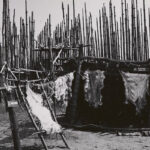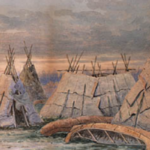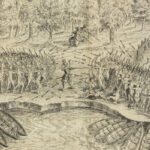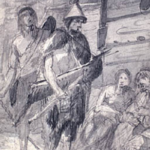O-Pipon-Na-Piwin Cree Nation: Guardians of the Boreal North
The O-Pipon-Na-Piwin Cree Nation (OPCN), located near South Indian Lake in northern Manitoba, is a testament to the resilience and adaptability of the Nehiyawak (Cree) people. Known for their deep connection to the waterways and forests of the boreal north, the community’s history is defined by their traditional ways of life, the challenges of industrial development, and their unwavering commitment to preserving their culture and land. Their name, meaning “winter camp” in Cree, reflects their enduring relationship with the natural environment that has sustained them for generations.
Ancient Origins: The Cree People of the Boreal Forest
The O-Pipon-Na-Piwin Cree Nation traces its ancestry to the Swampy Cree (Nehiyawak) people, who have lived in the boreal forests of northern Manitoba for thousands of years. Archaeological evidence, including ancient campsites and fishing weirs, points to their presence along the waterways of South Indian Lake for over 10,000 years. These waters provided abundant fish, and the surrounding forests were rich in game, berries, and medicinal plants.
The Cree’s traditional way of life revolved around the natural cycles of the land. Fishing, hunting, and trapping were the cornerstones of their economy, supplemented by gathering and trade. Seasonal movements ensured sustainable use of resources while maintaining a spiritual connection to the environment.
Anthropologist Robin Ridington, in Trail to Heaven: Knowledge and Narrative in a Northern Native Community, writes, “The Cree’s deep understanding of the boreal ecosystem allowed them to thrive in one of the most challenging environments in North America.”
Governance and Social Structure
The O-Pipon-Na-Piwin Cree Nation traditionally followed a governance model based on consensus and collective responsibility. Chiefs and leaders were chosen for their wisdom, bravery, and ability to mediate disputes and guide the community. Elders held a revered role as keepers of oral traditions and spiritual knowledge, ensuring that the community remained connected to its heritage.
The Cree were organized into family-based groups, with each group managing specific resources and territories. Ceremonies, such as the Sweat Lodge and the Pipe Ceremony, reinforced community bonds and spiritual practices, maintaining a balance between the physical and spiritual realms.
The Role of Waterways and the Fur Trade
The waterways surrounding South Indian Lake were integral to the Cree’s way of life and their role in the fur trade. As early as the 17th century, the Cree became key participants in the Hudson’s Bay Company (HBC) trade network. They acted as trappers, guides, and intermediaries, facilitating the exchange of furs for European goods such as firearms, metal tools, and textiles.
The fur trade brought both opportunities and challenges. While it provided access to new materials, it also introduced diseases like smallpox and influenza, which devastated Indigenous populations. Additionally, the overharvesting of fur-bearing animals disrupted traditional hunting and trapping practices.
Historian Arthur Ray, in Indians in the Fur Trade, observes, “The Cree’s role in the fur trade highlighted their adaptability and resourcefulness, but it also came at a cost to their traditional way of life.”
Treaty 5 and the Creation of the Reserve
In 1875, the O-Pipon-Na-Piwin Cree Nation became signatories to Treaty 5, a pivotal agreement between the Crown and Indigenous nations in northern Manitoba. The treaty guaranteed hunting, fishing, and trapping rights, as well as provisions for education and healthcare. In return, the Cree ceded vast tracts of land to the Crown.
For the O-Pipon-Na-Piwin Cree Nation, Treaty 5 was seen as a means of protecting their traditional livelihoods while adapting to the encroachment of settlers and industry. However, like other treaties, its implementation often fell short. The establishment of reserves under the Indian Act confined communities to small portions of their traditional territories, disrupting their access to vital resources.
Historian Margaret Conrad, in A Concise History of Canada, notes, “The promises of Treaty 5 were undermined by colonial policies that prioritized settler interests over Indigenous rights, leading to long-term challenges for Indigenous communities.”
The Impact of Hydroelectric Development
The construction of the Churchill River Diversion (CRD) in the 1970s had a profound impact on the O-Pipon-Na-Piwin Cree Nation. The CRD, which redirected water flow from the Churchill River to the Nelson River to support hydroelectric development, drastically altered the ecosystem of South Indian Lake. Flooding caused by the project destroyed fishing grounds, disrupted traditional livelihoods, and displaced many members of the community.
The O-Pipon-Na-Piwin Cree Nation has been at the forefront of efforts to address the environmental and social impacts of the CRD. Legal challenges, advocacy, and negotiations with Manitoba Hydro have highlighted the community’s determination to protect their rights and lands.
Chief Shirley Ducharme stated in a 2019 interview with CBC News, “The flooding of South Indian Lake was not just an environmental disaster; it was a cultural and economic crisis for our people. We are working to ensure our voices are heard and our rights respected.”
Resilience and Cultural Revitalization
Despite the challenges posed by industrial development and colonization, the O-Pipon-Na-Piwin Cree Nation has demonstrated remarkable resilience. Efforts to preserve the Cree language (Nehiyawêwin) and restore traditional practices have been central to the community’s cultural revitalization. Programs in education, cultural workshops, and youth mentorship ensure that future generations remain connected to their heritage.
The community has also taken significant steps toward self-determination. Legal settlements with Manitoba Hydro and partnerships with environmental organizations have provided resources to support economic development and cultural preservation.
Environmental Stewardship
The O-Pipon-Na-Piwin Cree Nation has long been a steward of the boreal forest and waterways surrounding South Indian Lake. Traditional ecological knowledge informs their practices in hunting, fishing, and land management. The community has become a leader in advocating for sustainable resource development and the protection of water quality in the region.
In The Resettlement of British Columbia, historian Cole Harris writes, “The Cree’s commitment to environmental stewardship is a reflection of their deep cultural ties to the land and water, which remain central to their identity.”
O-Pipon-Na-Piwin Cree Nation Today
Today, the O-Pipon-Na-Piwin Cree Nation is a thriving community with a population of over 2,000 members. The community blends traditional practices with modern governance and economic innovation. Investments in renewable energy, housing, and education reflect their commitment to sustainability and self-determination.
Annual cultural events, such as the Winter Camp Gathering, celebrate the community’s heritage and provide opportunities for members and visitors to engage with Cree traditions. These events reinforce the community’s resilience and pride in their culture.
A Legacy of Strength and Renewal
The history of the O-Pipon-Na-Piwin Cree Nation is a testament to their resilience, adaptability, and deep connection to the land. From their role in the fur trade and treaty-making to their leadership in addressing the impacts of hydroelectric development, the O-Pipon-Na-Piwin Cree have preserved their identity and place within Canada’s evolving landscape.
As Chief Shirley Ducharme stated, “Our story is one of pride, resilience, and a commitment to honouring our ancestors while building a sustainable and vibrant future for our community.”
References
Ridington, Robin. Trail to Heaven: Knowledge and Narrative in a Northern Native Community. Douglas & McIntyre, 1988.
Ray, Arthur J. Indians in the Fur Trade: Their Role as Hunters, Trappers, and Middlemen in the Lands Southwest of Hudson Bay, 1660-1870. University of Toronto Press, 1998.
Conrad, Margaret. A Concise History of Canada. Cambridge University Press, 2012.
Carter, Sarah. Lost Harvests: Prairie Indian Reserve Farmers and Government Policy. McGill-Queen’s University Press, 1990.
Ignace, Marianne and Ronald E. Ignace. Keeping the Stories Alive: Language, Land, and Culture in Indigenous Communities. University of Toronto Press, 2008.
Harris, Cole. The Resettlement of British Columbia: Essays on Colonialism and Geographical Change. UBC Press, 1997.
Trigger, Bruce G. Indigenous Peoples of Canada. McGill-Queen’s University Press, 1992.
Ducharme, Shirley. “The Impact of the Churchill River Diversion on South Indian Lake.” CBC News, 2019.
O-Pipon-Na-Piwin Cree Nation. Guardians of the Boreal: The History and Culture of O-Pipon-Na-Piwin Cree Nation. OPCN Publications, 2015.
Treaty 5 Elders. Voices of the North: Stories from Treaty 5 Communities. University of Manitoba Press, 2005.



